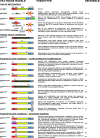In vivo analysis of p53 tumor suppressor function using genetically engineered mouse models
- PMID: 20097732
- PMCID: PMC2915627
- DOI: 10.1093/carcin/bgp331
In vivo analysis of p53 tumor suppressor function using genetically engineered mouse models
Abstract
p53 is a crucial tumor suppressor, as evidenced by the high propensity for p53 mutation during human cancer development. Already more than a decade ago, p53 knockout mice confirmed that p53 is critical for preventing tumorigenesis. More recently, a host of p53 knock-in mouse strains has been generated, with the aim of either more precisely modeling p53 mutations in human cancer or better understanding p53's regulation and downstream activities. In the first category, several mouse strains expressing mutant p53 proteins corresponding to human-tumor-derived mutants have demonstrated that mutant p53 is not equivalent to loss of p53 but additionally exhibits gain-of-function properties, promoting invasive and metastatic phenotypes. The second class of p53 knock-in mouse models expressing engineered p53 mutants has also provided new insight into p53 function. For example, mice expressing p53 mutants lacking specific posttranslational modification sites have revealed that these modifications serve to modulate p53 responses in vivo in a cell-type- and stress-specific manner rather than being absolutely required for p53 stabilization and activation as suggested by in vitro experiments. Additionally, studies of p53 mouse models have established that both p53-driven cell-cycle arrest and apoptosis responses contribute to tumor suppression and that activation of p53 by oncogenic stress imposes an important barrier to tumorigenesis. Finally, the use of mouse strains expressing temporally regulatable p53 has demonstrated that p53 loss is not only required for tumor development but also required for tumor maintenance, suggesting that p53 restoration in human cancer patients may be a promising therapeutic strategy. These sophisticated p53 mouse models have taught us important lessons, and new mouse models will certainly continue to reveal interesting and perhaps surprising aspects of p53's complex biology.
Figures

Similar articles
-
Illuminating p53 function in cancer with genetically engineered mouse models.Semin Cell Dev Biol. 2014 Mar;27:74-85. doi: 10.1016/j.semcdb.2013.12.014. Epub 2014 Jan 3. Semin Cell Dev Biol. 2014. PMID: 24394915 Free PMC article. Review.
-
p53 gain-of-function cancer mutants induce genetic instability by inactivating ATM.Nat Cell Biol. 2007 May;9(5):573-80. doi: 10.1038/ncb1571. Epub 2007 Apr 8. Nat Cell Biol. 2007. PMID: 17417627
-
Tumor suppressor p53 and its gain-of-function mutants in cancer.Acta Biochim Biophys Sin (Shanghai). 2014 Mar;46(3):170-9. doi: 10.1093/abbs/gmt144. Epub 2013 Dec 29. Acta Biochim Biophys Sin (Shanghai). 2014. PMID: 24374774 Free PMC article. Review.
-
Senescence and aging: the critical roles of p53.Oncogene. 2013 Oct 24;32(43):5129-43. doi: 10.1038/onc.2012.640. Epub 2013 Feb 18. Oncogene. 2013. PMID: 23416979 Review.
-
Mechanisms of mutant p53 stabilization in cancer.Subcell Biochem. 2014;85:187-97. doi: 10.1007/978-94-017-9211-0_10. Subcell Biochem. 2014. PMID: 25201195
Cited by
-
P53 aggregation, interactions with tau, and impaired DNA damage response in Alzheimer's disease.Acta Neuropathol Commun. 2020 Aug 10;8(1):132. doi: 10.1186/s40478-020-01012-6. Acta Neuropathol Commun. 2020. PMID: 32778161 Free PMC article.
-
Gene Expression Regulation and the Signal Transduction of Programmed Cell Death.Curr Issues Mol Biol. 2024 Sep 16;46(9):10264-10298. doi: 10.3390/cimb46090612. Curr Issues Mol Biol. 2024. PMID: 39329964 Free PMC article. Review.
-
Mitochondrial dysfunction impairs tumor suppressor p53 expression/function.J Biol Chem. 2011 Jun 10;286(23):20297-312. doi: 10.1074/jbc.M110.163063. Epub 2011 Apr 18. J Biol Chem. 2011. PMID: 21502317 Free PMC article.
-
Comparison of the metabolic activation of environmental carcinogens in mouse embryonic stem cells and mouse embryonic fibroblasts.Toxicol In Vitro. 2015 Feb;29(1):34-43. doi: 10.1016/j.tiv.2014.09.004. Epub 2014 Sep 16. Toxicol In Vitro. 2015. PMID: 25230394 Free PMC article.
-
Interplay between HMGA and TP53 in cell cycle control along tumor progression.Cell Mol Life Sci. 2021 Feb;78(3):817-831. doi: 10.1007/s00018-020-03634-4. Epub 2020 Sep 12. Cell Mol Life Sci. 2021. PMID: 32920697 Free PMC article. Review.
References
-
- Soussi T. p53 alterations in human cancer: more questions than answers. Oncogene. 2007;26:2145–2156. - PubMed
-
- Varley JM. Germline TP53 mutations and Li-Fraumeni syndrome. Hum. Mutat. 2003;21:313–320. - PubMed
-
- Clarke AR, et al. Thymocyte apoptosis induced by p53-dependent and independent pathways. Nature. 1993;362:849–852. - PubMed
-
- Donehower LA, et al. Deficiency of p53 accelerates mammary tumorigenesis in Wnt-1 transgenic mice and promotes chromosomal instability. Genes Dev. 1995;9:882–895. - PubMed
-
- Donehower LA, et al. Mice deficient for p53 are developmentally normal but susceptible to spontaneous tumours. Nature. 1992;356:215–221. - PubMed
Publication types
MeSH terms
Substances
LinkOut - more resources
Full Text Sources
Molecular Biology Databases
Research Materials
Miscellaneous

